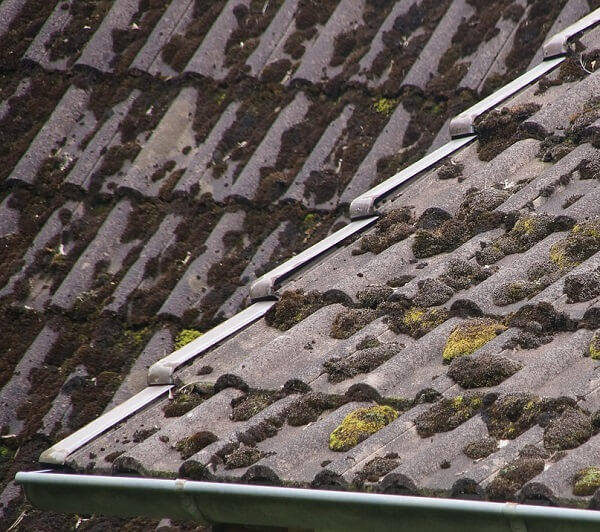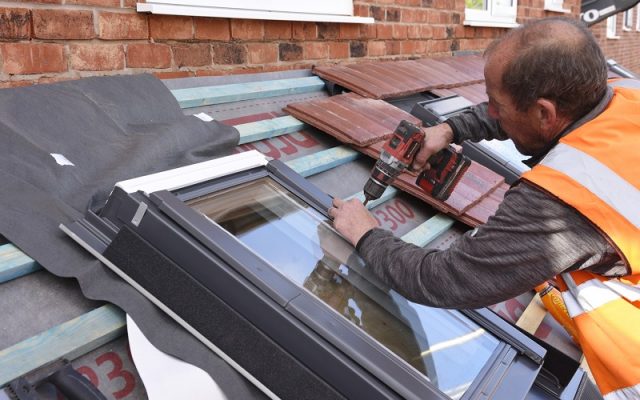Aging Roof
According to the International Association of Certified Home Inspectors, a typical asphalt shingles roof should last for up to 30 years but this depends on local weather conditions. If you live somewhere where the climate is warm, the asphalt shingles will deteriorate much quicker than normal.
The same can be said for colder climates. If you live in a location that has frequent hail, tornados or hurricanes, your roof will also suffer from a shorter lifespan. Consider when your roof was installed and when it was last inspected. If it was more than a few decades, it’s worth giving your local roofer a call.

Loose Roof Tiles or Curling Shingles
Loose tiles and curling shingles can indicate a few issues about your roof. If your roof is suffering from curling shingles it can mean that the shingles that were used could have been of poor quality. If this is the case, you can simply replace the curled shingles with new ones before it causes any serious deterioration.
Loose roof tiles can be easily checked when on top of your roof. Safely press your hand or foot onto each tile and ensure they’re secure. If multiple tiles are loose, it could be an indication of a weak roof so you should act quickly and contact a local roofer so that they can check for any weaknesses in the roof.

Missing Tiles or Shingles
Having a few tiles or shingles missing is something not to be that concerned about unless you’re experiencing leaks. In this case, you should call a roofer and get the tiles replaced. The only issue you may face is that the colour of tiles and shingles can change over time, meaning that you may find it difficult to find a matching shingle or tile.
Roof Granules in the Gutter
If you notice roof granules in the gutters around your roof, or in an outside drain, this can sometimes be very alarming. If you’ve had your roof for around 10 to 15 years this could be the start of a serious issue. The granules protect the asphalt from the sun’s rays and without that protection, you can see your asphalt worsen quickly from the heat. This can lead to leaks, which can damage your property. If you spot this, talk to your local roofer. It might be time to replace it!
If you have recently had your roof replaced or worked on this is perfectly natural and will normally just be residue from the job.
Moss or Algae Growth
Like any type of structure or building, being on top of moss and algae is a must. Letting moss wreck havoc on your roof is something nobody wants to deal with and you should act quickly when you notice it.
The way moss can attack a roof is different to what you may expect. Moss can push itself in between tiles and shingles and push them apart, leaving room for the elements to seep into your roof. This can result in water damage and even potential structural damage. It’s best to periodically clean the moss from the roof to prevent damage. If it’s been left too long, however, you might need to look at replacing your roof.

The Roof is Sagging
Normally, your roof should be a consistent straight line alongside the roof ridge, the ridge being the highest point of your roof. But sometimes roofs can sag. Roof sagging is when your roof is inconsistent or could be described as having a “sag” or “saddleback”. This can be a warning sign for structural damage, so be on the lookout for any inconsistencies in your roof.
Sagging can occur when roofs are constantly exposed to prolonged moisture. Locations that have lengthy spells of rain or snow will be the main spots that have the most issues with sagging but buildings with flat roofs are the most at risk. Having a flat roof means that water can collect and remain for days without evaporating, extending the exposure.
Damaged Underlay
The underlay is just as important as the tiles and shingles. Without both being in great condition, water can have the opportunity to seep through. The underlay is the material that goes underneath the tiles or shingles so spotting a tear can be tricky.
If you spot a leak and your tiles seem to be in great condition, your underlay maybe rotting or damaged. If you have a small tear in the underlay, there’s an opportunity to just replace the damaged area. However, if it’s rotting, this can lead to a weakened roof and you should look at getting it replaced as soon as possible.
Sunlight Seeping Through
One of the more obvious indications that something is wrong with your roof could be that you can see sunlight seeping through the attic. If light can get through, so can rain and snow.
The time you have to act in these circumstances can differ from the type of leak you have. All leaks should be taken seriously but if you catch it early on, a simple patch up can do the trick. If left untreated, the leaks can become larger and interfere with the roof’s integrity so you should act fast.
Paper Trail
Keeping all documents regarding the work you have had completed on your roof is a great way to extend its life expectancy. Having the knowledge of what your roof is made out of, when it was installed and if it has had any problems in the past is valuable information and could save you time and money in the long run.
Water Damage
Finding water damage in your house can be very alarming – for good reason! If you do find water damage in the upper part of your house, be sure to contact a professional immediately to avoid further damage or you may incur a large bill.
How much does a roof replacement cost?
Checkatrade state that the UK national average cost to replace a roof is £5,500. Most homeowners spend between £3,000 to £16,300, with the higher prices being bespoke roofs with complex measurements.
The price of a roof replacement can fluctuate when you take into consideration what types of material are being used. Tiles are the most popular choice of roof material but prices can differ because of size and quality.
You also need to take into consideration external fees such as scaffolding, insulation and the removal of old shingles and tiles.
Does home insurance cover a roof replacement?
In some cases, home insurance can cover complete roof replacements but these are very rare. If a roof has slowly deteriorated over a long period of time, most insurance companies will not pay out for any repairs on the roof.
If a roof was damaged by a heavy storm or a freak accident, like a tree falling onto your house, there is a possibility that your roof repairs will be covered by your home insurance.


